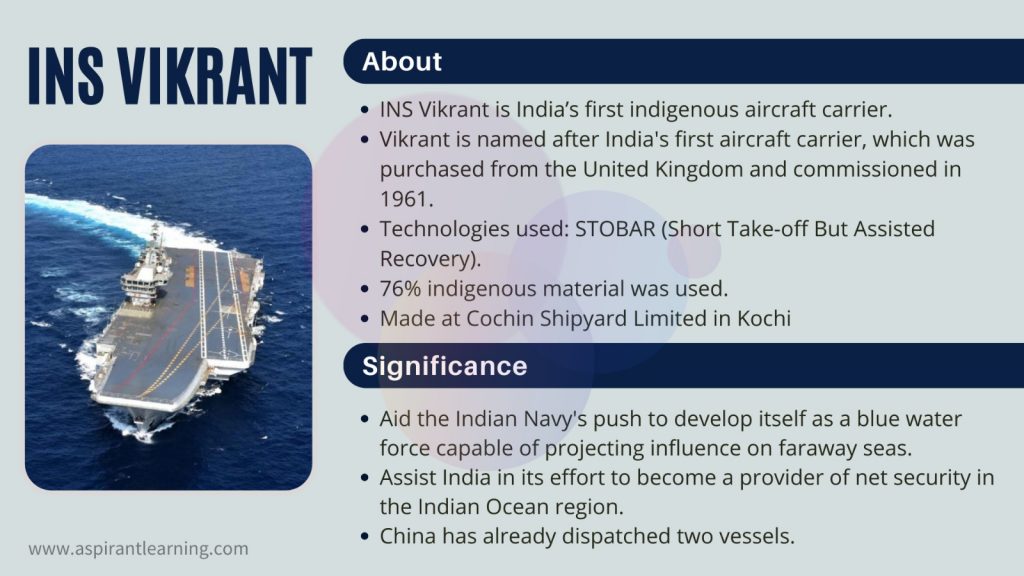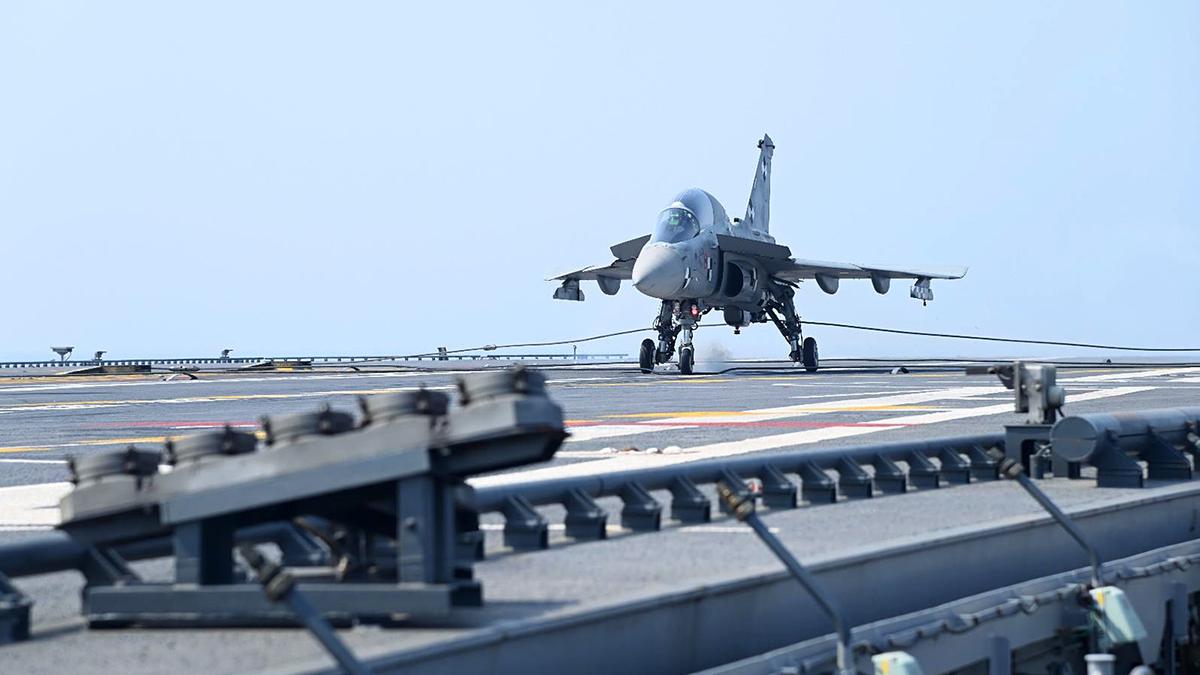News Highlight
Indigenous carrier INS Vikrant will be fully operational by year-end: Navy Chief.
Key Takeaway
- The country’s first indigenous aircraft carrier, INS Vikrant, which is now undergoing trials, is expected to be fully operational by the end of the year.
- Earlier this month, the indigenous Light Combat Aircraft (LCA-Navy) and Mig-29K made their first landings on the ship.
INS Vikrant
- About
- INS Vikrant is India’s first indigenous aircraft carrier.
- It is sometimes referred to as Indigenous Aircraft Carrier One (IAC-1).
- Cochin Shipyard in Kerala is building it for the Indian Navy.
- It has a 76% indigenous composition altogether.
- It works on Short Take-Off But Arrested Recovery Mechanism (STOBAR).
- This technique is remarkably similar to the current carrier INS Vikramaditya.
- Four General Electric gas turbines power the INS Vikrant.
- “Jayema Sam Yudhi Sprdhah” is the motto of INS Vikrant.
- It came from the Rig Veda.
- “I overcome those who oppose me,” it signifies.
- Features
- The Vikrant is 262 metres long, longer than two football fields and 62 metres broad.
- The hangar can accommodate up to 20 aircraft.
- It has a top speed of around 28 knots and a cruising speed of 18 knots, with a range of approximately 7,500 nautical miles.
- Over 76% of the material and equipment on board the carrier is indigenous, including 21,500 tonnes of special-grade steel manufactured in-house and used for the first time in Indian naval ships.
- This is the first time in the country that an aircraft carrier-sized ship has been designed in 3D and production drawings have been derived from the 3D model.
- The Made-in-India battleship is a feather in the country’s crown, as only five or six nations can build an aircraft carrier.
Significance of INS Vikrant
- Global Recognition
- With the commissioning of INS Vikrant, India has joined a small group of nations with the unique capability of designing and building an aircraft carrier in-house.
- Employment Generation
- With 76% indigenous material, the building of INS Vikrant has directly employed over 2,000 CSL personnel.
- In addition, it has led to the indirect employment of around 12,500 people for over 550 OEMs, subcontractors, and ancillary sectors.
- Furthermore, over 100 MSMEs will benefit from the plough-back effect on the economy.
- Major Step to Atmanirbharta
- During the ‘Azadi ka Amrit Mahotsav,’ INS Vikrant demonstrated the ‘Aatmanirbhar’ credentials.
- INS Vikrant is also a testimony to the Nation’s desire for self-reliance and ‘Make in India’.
- Strengthening Maritime Security Capabilities in the IOR
- A proper tribute to the country’s energy and enthusiasm in pursuing capability development in the Indian Ocean Region (IOR) for increased maritime security.

Challenges
- Cost and Time Overruns
- Throughout most production projects, the Navy suffers from cost and timing overruns.
- For example, the INS Vikramaditya entered service more than ten years after it was purchased.
- Old technology
- A submarine fleet is essential for supporting the Navy’s aircraft carriers, among other responsibilities.
- The Navy now has 15 conventional submarines, each requiring breaking surfaces to charge its batteries, rendering it vulnerable to detection every time it is launched.
- Growing Chinese Influence in the Indian Ocean
- Building on its anti-piracy missions, China has emerged as a major partner for Indian Ocean islands and coastal countries.
- It includes its recent vessel deployment in Hambantota Port, Sri Lanka.
Conclusion
- India needs at least three carriers given the maritime sector’s current geopolitical and strategic importance.
- India’s stake in the IOR is bigger than its stake in the high Himalayas, as India is the only member of QUAD.
- The Navy can be organised, trained, and equipped to promote India’s national security interests and prosperity during peacetime.
- As well as for responding to combat occurrences at sea.
Pic Courtesy: The Hindu
Content Source: The Hindu



